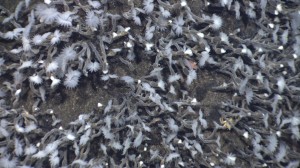13 December 2010
The Coral Triangle’s dark secret: Life thrives in the deep
Posted by mohi
Between the Indonesian islands that arc north towards the Philippines, the ocean floor is pockmarked with deep basins and underwater volcanoes. It is an area where oceanic currents collide, tectonic plates die, and species burst forth in a proliferation rarely seen elsewhere on Earth. The shallow areas are best known as the Coral Triangle, where warm seas house coral reefs and an abundance of fish species.
But in this morning’s session OS11D “Ocean Exploration 1,” researchers presented evidence that the deep basins that dot Coral Triangle have the potential to mirror the diversity of shallower areas. As part of a joint ocean research project between the National Oceanic and Atmospheric Administration (NOAA) and Indonesia, Santiago Herrera of the Woods Hole Oceanographic Institution discussed the different habitats and species found thousands of meters below the ocean surface.

Deep sea barnacles on Kawio Barat, an underwater volcano off Indonesia's coast. Image courtesy of NOAA/INDEX
The slopes of Kawio Barat, an underwater volcano, are wreathed in a chemical soup where shrimp, barnacles, worms and clams thrive. Herrera said they discovered a shrimp and a barnacle that, based on what they could see in high-resolution photographs, may be new to science. But he cautioned that since they weren’t able to sample them, they couldn’t confirm their observations.
Bottom habitats on other seamounts sheltered glass sponges, black corals, and a bubblegum coral that might also be a new species. Herrera added that corals have a higher prevalence of “cryptic species”–species that look the same but are in fact different, and so the potential for future discoveries in the area is very promising.
Seeing the abundant life and new species from this research expedition sparked a remembrance from my science research days of all the ways this area could produce new species. Indonesia and the surrounding regions are a transitional area for terrestrial flora and fauna between Asian species to the north and Australian species to the south. There was speculation that the waters surrounding these islands were also transitional areas for marine creatures. The idea was that the swift currents that blow between the islands of Indonesia could help to isolate animal populations to the north and south.
Whether this hypothesis holds awaits more data from future expeditions to this area and scientists like Herrera.
–Jane Lee is a science communication graduate student at UC Santa Cruz



 GeoSpace is a blog on Earth and space science, managed by AGU’s Public Information staff. The blog features posts by AGU writers and guest contributors on all sorts of relevant science topics, but with a focus on new research and geo and space sciences-related stories that are currently in the news.
GeoSpace is a blog on Earth and space science, managed by AGU’s Public Information staff. The blog features posts by AGU writers and guest contributors on all sorts of relevant science topics, but with a focus on new research and geo and space sciences-related stories that are currently in the news.